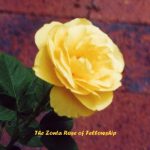The Zonta Rose Story
 To us the beauty of a single yellow rose has been a favourite Zonta symbol for 40 years. The “Zonta Rose” was introduced at the 1984 Sydney Convention, thanks to the dedication and support of District 16 Zontians.
To us the beauty of a single yellow rose has been a favourite Zonta symbol for 40 years. The “Zonta Rose” was introduced at the 1984 Sydney Convention, thanks to the dedication and support of District 16 Zontians.
In 1983, then Lieutenant Governor of District 16 (New Zealand), Valerie Webster, proposed that a breed of roses be developed as a living symbol of Zonta International. The renowned England- based nursery Harkness Roses worked to cultivate the flower, while Zontian Maureen Ross of Ross Roses in Adelaide, Australia enabled it to be introduced at the Convention.

Roses in Rockhampton
Today, the lovely yellow bloom can be seen in members’ gardens, memorial plantings, schools, hospitals, homes for the elderly, and in the forecourt of Australia’s National Parliament in Canberra.
A Zonta Rose Bed was inaugurated at Bältesspännarparken in Gothenburg, Sweden, as part of the 2002 Zonta International Convention festivities. The Zonta Rose itself has bright yellow blooms, produced in large sprays, and neatly spaced to form a bouquet.
Each bloom is formed on its own long stem and has a particularly long life, whether on the bush or cut. Its fragrance is light and pleasant, while gardeners will appreciate that it is easy to grow and hardy, reaching an average of 1.2 meters in height.
The Zonta Rose is registered internationally under the name “Hartanna.” It also goes by the name “Princess Alice” in Canada and the UK, and “Bright Lites” in the USA.

Zonta Convention – Rotterdam – 2008
Jan, Berenice, Norma, Ros and Elizabeth at Convention
(Rockhampton Zontians with District Governor Ros)
Each feature of the Zonta Rose has a special significance:
- The ROOTS signify the foundation of Zonta, our objectives, mission and our history.
- The TRUNK stands for our strength and ability to unite to advance the status of women.
- The BRANCHES symbolize the network and direction of many clubs in many countries, improving the lives of many women.
- The LEAVES represent growth of our personal lives and the Zonta organization.
- The STEMS signify the links between clubs and members.
- Multiple BLOOMS represent Zonta’s diversity in membership, while the BUDS characterize new members to be nurtured and treasured.
- The ROSE epitomizes Zonta friendship and mutual support, with the intertwined golden yellow PETALS embodying the principles of Zonta – honesty and trustworthiness.
- The PERFUME is the gift to our fellow man, representing Zonta service to the local and global community.
 But the Zonta Rose is much more than a lovely flower. Since 1999, it has served as the symbol of Zonta Rose Day, which falls on 8 March and coincides with International Women’s Day. On this special day, Zontians worldwide are encouraged to publicly distribute yellow roses or items bearing the image of yellow roses, accompanied by information about Zonta International and issues relating to improving the lives of women.
But the Zonta Rose is much more than a lovely flower. Since 1999, it has served as the symbol of Zonta Rose Day, which falls on 8 March and coincides with International Women’s Day. On this special day, Zontians worldwide are encouraged to publicly distribute yellow roses or items bearing the image of yellow roses, accompanied by information about Zonta International and issues relating to improving the lives of women.
Information from Zonta.org Roses grown in Rockhampton, Qld, Australia.
